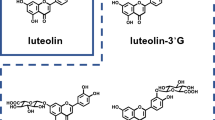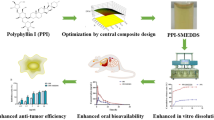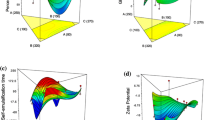Abstract
Due to intestinal cytochrome P450 (CYP450)-mediated metabolism and P-glycoprotein (P-gp) efflux, poor oral bioavailability hinders ginsenoside-Rh1 (Rh1) and ginsenoside-Rh2 (Rh2) from clinical application. In this study, Rh1 and Rh2 were incorporated into two self-microemulsions (SME-1 and SME-2) to improve oral bioavailability. SME-1 contained both CYP450 and P-gp inhibitory excipients while SME-2 only consisted of P-gp inhibitory excipients. Results for release, cellular uptake, transport, and lymph node distribution demonstrated no significant difference between either self-microemulsions in vivo, but were elevated significantly in comparison to the free drug. The pharmaceutical profiles in vivo showed that the bioavailability of Rh1 in SME-1 (33.25%) was significantly higher than that in either SME-2 (21.28%) or free drug (12.92%). There was no significant difference in bioavailability for Rh2 between SME-1 (48.69%) or SME-2 (41.73%), although they both had remarkable increase in comparison to free drug (15.02%). We confirmed that SME containing CYP450 and P-gp inhibitory excipient could distinctively improve the oral availabilities of Rh1 compared to free drug or SME containing P-gp inhibitory excipient. No notable increase was observed between either SME for Rh2, suggesting that Rh2 undergoes P-gp-mediated efflux, but may not undergo distinct CYP450-mediated metabolism.






Similar content being viewed by others
Abbreviations
- Rh1:
-
ginsenoside-Rh1
- Rh2:
-
ginsenoside-Rh2
- CYP450:
-
cytochromes P450
- SME:
-
self-microemulsion
- AUC:
-
area under the curve
- MEM:
-
minimum essential medium
- NEAA:
-
non-essential amino acid
- FBS:
-
fetal bovine serum
- TEER:
-
transepithelial electrical resistance
- SPF:
-
specific pathogen free
- DOS-1227:
-
dammarane oligosaponins
References
Kim JH, Yi Y-S, Kim M-Y, Cho JY. Role of ginsenosides, the main active components of Panax ginseng, in inflammatory responses and diseases. J Ginseng Res. 2016:1–9.
Quan K, Liu Q, Wan JY, Zhao YJ, Guo RZ, Alolga RN, et al. Rapid preparation of rare ginsenosides by acid transformation and their structure-activity relationships against cancer cells. Sci Rep. 2015;5:8598.
Deok Chun Yang KJY, Choi YE. Production of red ginseng specific ginsenosides (Rg2, Rg3, Rh1 and Rh2) from Agrobacterium—transformed hairy roots of Panax ginseng by heat treatment. J Photoscience. 2001;8:19–22.
Wu JYGB, Murphy CI, Seals JR, Kensil CR, Recchia J, Beltz GA, et al. Saponin adjuvant enhancement of antigen-specific immune responses to an experimental HIV-1 vaccine. J Immunol. 1992;148:1519–25.
Yoon JH, Choi YJ, Lee SG. Ginsenoside Rh1 suppresses matrix metalloproteinase-1 expression through inhibition of activator protein-1 and mitogen-activated protein kinase signaling pathway in human hepatocellular carcinoma cells. Eur J Pharmacol. 2012;679:24–33.
Wakabayashi CHH, Murata J, Saiki I. In vivo antimetastatic action of ginseng protopanaxadiol saponins is based on their intestinal bacterial metabolites after oral administration. Oncol Res. 1997;9:411–7.
Park JALK, Oh YJ, Kim KW, Lee SK. Activation of caspase-3 protease via a Bcl-2-insensitive pathway during the process of ginsenoside Rh2-induced apoptosis. Cancer Lett. 1997;121:73–81.
Cheng CC, Yang SM, Huang CY, Chen JC, Chang WM, Hsu SL. Molecular mechanisms of ginsenoside Rh2-mediated G1 growth arrest and apoptosis in human lung adenocarcinoma A549 cells. Cancer Chemother Pharmacol. 2005;55:531–40.
Jia WW, Bu X, Philips D, Yan H, Liu G, Chen X, et al. Rh2, a compound extracted from ginseng, hypersensitizes multidrug-resistant tumor cells to chemotherapy. Can J Physiol Pharmacol. 2004;82:431–7.
Xie X, Eberding A, Madera C, Fazli L, Jia W, Goldenberg L, et al. Rh2 synergistically enhances paclitaxel or mitoxantrone in prostate cancer models. J Urol. 2006;175:1926–31.
Qian T, Cai Z, Wong RN, Jiang ZH. Liquid chromatography/mass spectrometric analysis of rat samples for in vivo metabolism and pharmacokinetic studies of ginsenoside Rh2. Rapid communications in mass spectrometry : RCM. 2005;19:3549–54.
Lai L, Hao H, Liu Y, Zheng C, Wang Q, Wang G, et al. Characterization of pharmacokinetic profiles and metabolic pathways of 20(S)-ginsenoside Rh1 in vivo and in vitro. Planta Med. 2009;75:797–802.
Gu Yi WG, J S, H X, Y J, M X, Hua L, et al. Pharmacokinetic study of ginsenoside 20(R)-Rh2 in beagle dogs by LC-ESI-MS. Chin J Clin Pharmacol Ther. 2006;11:256–60.
Yang Z, Gao S, Wang J, Yin T, Teng Y, Wu B, et al. Enhancement of oral bioavailability of 20(S)-ginsenoside Rh2 through improved understanding of its absorption and efflux mechanisms. Drug Metab Dispos: Biol fate Chem. 2011;39:1866–72.
Gu Y, Wang GJ, Sun JG, Jia YW, Wang W, Xu MJ, et al. Pharmacokinetic characterization of ginsenoside Rh2, an anticancer nutrient from ginseng, in rats and dogs. Food Chem Toxicol: Int J Published Brit Ind Biol Res Assoc. 2009;47:2257–68.
Zhou J, Zhou M, Yang F, Liu C, Pan R, Chang Q, et al. Involvement of the inhibition of intestinal glucuronidation in enhancing the oral bioavailability of resveratrol by labrasol containing nanoemulsions. Mol Pharm. 2015;12:1084–95.
Yang F, Zhou J, Liu C, Hu X, Pan R, Chang Q, et al. Cytochromes P450 inhibitory excipient-based self-microemulsions for the improved bioavailability of protopanaxatriol and protopanaxadiol: preparation and evaluation. Planta Med. 2016;
Bansal T, Akhtar N, Jaggi M, Khar RK, Talegaonkar S. Novel formulation approaches for optimising delivery of anticancer drugs based on P-glycoprotein modulation. Drug Discov Today. 2009;14:1067–74.
Yang F, Zhou J, Liu C, Hu X, Pan R, Chang Q, et al. Cytochromes P450 inhibitory excipient-based self-microemulsions for the improved bioavailability of protopanaxatriol and protopanaxadiol: preparation and evaluation. Planta Med. 2016;
Wu L, Qiao Y, Wang L, Guo J, Wang G, He W, et al. A self-microemulsifying drug delivery system (SMEDDS) for a novel medicative compound against depression: a preparation and bioavailability study in rats. AAPS PharmSciTech. 2015;16:1051–8.
Amri A, Clanche L, Therond P, Bonnefont-Rousselot D, Borderie D, Lai-Kuen R, et al. Resveratrol self-emulsifying system increases the uptake by endothelial cells and improves protection against oxidative stress-mediated death. Eur J Pharm Biopharm: Off J Arbeitsgemeinschaft fur Pharmazeutische Verfahrenstechnik eV. 2014;(86):418–26.
Kohli K, Chopra S, Dhar D, Arora S, Khar RK. Self-emulsifying drug delivery systems: an approach to enhance oral bioavailability. Drug Discov Today. 2010;15:958–65.
Wu X, Xu J, Huang X, Wen C. Self-microemulsifying drug delivery system improves curcumin dissolution and bioavailability. Drug Dev Ind Pharm. 2011;37:15–23.
Acknowledgments
This work was supported by the National Natural Science Foundation of China (Grant No. 81603052), the Beijing Natural Science Foundation (Grant No. 7164280), the CAMS Initiative for Innovative Medicine (CAMS-I2M, Grant No. 2016-I2M-2-006), and the Key Laboratory for Neurodegenerative Diseases (Capital Medical University), Ministry of Education (Grant No. 2015SJBX03).
Author information
Authors and Affiliations
Corresponding author
Ethics declarations
All institutional and national guidelines for the care and use of laboratory animals were followed
Conflict of interest
The authors declare that they have no conflict of interest.
Electronic supplementary material
ESM 1
(DOCX 58 kb)
Rights and permissions
About this article
Cite this article
Yang, F., Zhou, J., Hu, X. et al. Preparation and evaluation of self-microemulsions for improved bioavailability of ginsenoside-Rh1 and Rh2. Drug Deliv. and Transl. Res. 7, 731–737 (2017). https://doi.org/10.1007/s13346-017-0402-7
Published:
Issue Date:
DOI: https://doi.org/10.1007/s13346-017-0402-7




